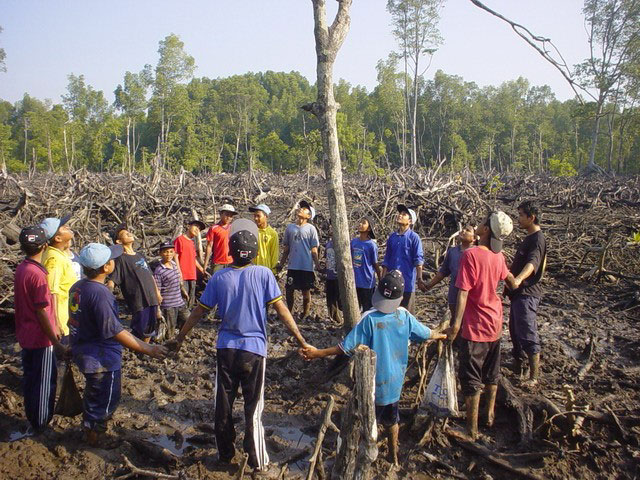PREVIEW VERSION
|
The MAP News |
|
|
MAP calls for attention to mangrove loss in Pitas, Sabah Malaysian
 MALAYSIA - The Pitas development is a government initiative through state subsidiary company Inno Fisheries Sdn in collaboration with Sunlight Seafood (Sabah) Sdn Bhd, is reported to entail a RM1.23 bn (c US $320m) investment and the creation of about 1,500 shrimp ponds. Around 20% of the total funding is from state sources. Yayasan Sabah’s Inno-Fisheries is a government agency whose website states its mission as being “to uplift the quality of life of Malaysians in Sabah”. Sunlight Seafood is one of the leading processors and exporters of frozen seafood products in Malaysia. Local people, however, do not see the benefits. Noridah Samad, a local youth and a member of the G6 collective says: “Seeing our land being destroyed in the name of profit making, impedes us from sustaining our traditional livelihoods and culture. With the destruction of the 2300 ac, many youths will never learn the ways of our grandfathers and traditional knowledge will be lost.” Another local farmer and fisherman, also a member of the G6 collective, says that the shrimp farm developments over 2300 acres have significantly depleted resources and affected the livelihood of subsistence farmers and fishermen in the area. Speaking at a press conference organised by Sabah Environmental Protection Association (SEPA) in 2015, he said: “We now have remaining about 1,000 acres of mangrove land which has a sensitive biosystem and hold our livelihood as well as traditional practises like traditional medicine, building materials and sacred sites. “We are concerned that any further expansion of the farm into this land will permanently and completely destroy our source of income and livelihood on the very ground that we have lived on for eight generations now.” READ MORE AFRICA In Central African Republic, natural wealth so near and yet so far for most  CAR - For Central African Republic to develop, the immense wealth of its tropical forests must be shared among its people. Despite its vast natural resources, in 2016 CAR was ranked last in the U.N.'s Human Development Index of 188 nations. Meanwhile 2.5 million out of a population of 4.6 million are estimated to be in need of humanitarian assistance, and average life expectancy languishes at 51.5 years. If the country is to be lifted from its plight, the forest sector must play a central role. The industry is the country’s second largest employer (after the state), while timber is CAR’s number one official export – its position assuming greater importance in the economy since the Kimberley Process cracked down on ‘conflict’ diamonds. But for change to occur, then the corruption that has plagued the forest sector for generations must end, along with the flow of illegal timber that still saturates the market. To grasp the scale of the challenge, it’s necessary to understand its context.READ MORE ASIA Editor’s Note: The young country’s amazing marine life has created hope that visitors could uplift its urgently poor economy. But preservation concerns remain. Tourists Could Be East Timor’s Lifeline. But Will They Ruin Its Reefs?  INDONESIA - On a rainy spring morning, Fizzy Moslim strapped on her weathered-chrome diving tank and slipped into the warm water. Few visitors make it out to the sleepy fishing village of Com, a backbreaking seven-hour drive from the capital, and usually no one except the locals ever dives into its waters. Below she found an underwater metropolis. Sea turtles swam beside hundreds of reef fish, feeding on the rich coral below. Two young dugong, a manatee-like sea mammal, sped away, and a blacktip reef shark swam along the ocean floor. “This isn’t even nearly the best of what I’ve seen,” said Ms. Moslim, an instructor for Compass Diving tours, as she came up from the depths. In March, Ms. Moslim and a team of divers and conservationists set out on a mission to chart these sea sanctuaries in hopes of bringing in a new kind of species here: tourists. “If these corals will stay strong, the people around them will need the money to keep them safe,” said Trudiann Dale, the East Timor country director for Conservation International. “Eco-tourism, if done right, could provide that.” READ MORE Citizens, NGOs fighting to save mangroves, wetlands across Mumbai  INDIA - With land mafia eyeing mangroves and wetlands across Mumbai, citizens, NGOs, state machinery as well as courts are focusing on conserving these green spaces in the financial capital of the country. According to non-profit Mangrove Society of India (MSI), intertidal regions are in high demand as they can be potential hotspots for construction and infrastructure development. HT has been consistently reporting and breaking stories related to mangrove and wetland destruction over the past year, with major cases and conservation-related developments over the past month. “A battle is underway in Mumbai,” said Arvind Untawale, executive secretary, MSI. “Citizens, NGOs and state government bodies are on one side against the space-starved builder lobby eyeing mangrove and wetland patches, some of the last remaining open areas that protect the city from flooding. Many cases in private areas, especially involving the builder lobby, have gone undetected where structures such as housing complexes, apartments and several private projects are currently built. With increasing awareness, citizens have forced the state machinery to act against them, and we are currently witnessing a contest between development and conservation.” READ MORE Open University collaborate for Thailand’s coastal resources THAILAND - Mangroves for the Future (MFF) and Marriott Resort and Hotels have joined hands with Sukhothai Thammathirat Open University to improve the sustainability of communities’ livelihoods and bolster conservation efforts in Bangkaeo Sub-district of Samut Songkram Province, Central Thailand. Co-funded by MFF and Marriott Hotels and Resorts, an IUCN partner, the initiative is part of MFF’s Small Grant Facility for Private Sector Engagement, in which MFF matches cash funding from the private sector to implement small projects in MFF countries. The objectives of the initiative, which started in March, are primarily to establish an Integrated Coastal Management (ICM) network, develop a community-based land use map and sustainable management plan, and utilise the management plan to restore mangroves and create sustainable livelihood opportunities. READ MORE Mangrove forest to make way for road upgrade  MALAYSIA - Malaysian Nature Society (MNS) is worried about the effects from a road upgrading project cutting through the mangrove forest in Sepang. According to the staff at MNS’ Sepang Environmental Interpretive Centre, the 10km-long Jalan Besar Salak (B48) will be upgraded in stages starting from the junction at Simpang Tiga Jenderam up to Pekan Sepang Lama. The project by Selangor Public Works Department (JKR) will widen the single-lane road to four-lane dual carriageway. Residents have been complaining about heavy congestion anytime in the day. “We received a notice that trees will be chopped down from March 19 onwards,” said MNS executive director Shanmugaraj Subramaniam. He said about 70 trees would be felled. READ MORE AMERICAS Teen Plants Hundreds of Mangroves to Replace Trees Trampled by Hurricane Irma  USA - After Hurricane Irma ravaged the South Florida landscape in 2017, an 18-year-old took it upon himself to protect and preserve the environment – and he did it from the roof of his house. Though the tropical storm wreaked havoc on buildings and properties, Theo Queenee was primarily shocked by how many mangroves had been damaged by the tropical storm. Mangroves are an essential part of a marine eco-system. In addition to providing a healthy and complex habitat for fish, sharks, and turtles, they also protect the coastline from erosion. ”After the hurricane there was a massive amount of [mangrove] seedlings mixed within the seaweed/debris mixture,” Queenee told Mother Nature Network. “Everything was then going to be gathered and thrown in a truck to dump at a landfill. I realized that all of South Florida would ultimately kill thousands of mangroves in the clean-up process.” READ MORE The tropical family tree: Tracking forests’ evolutionary past  USA - Scientists have traced the evolutionary history of the world’s tropical forests, with some surprising results – and new insights that may help improve responses to climate change. To the uninitiated, tropical forests in Africa, Asia and Latin America might look the same: exuberant green vegetation from the forest floor to the canopy. Look closer, and they are actually quite different. Just 4% of tropical tree species are found on all three continents. There are very few palms in the African forests, for example, while in Asia and Latin America palm fronds are found throughout the understory. Based on the few shared species, scientists initially made a distinction between the ‘old world’ forests of Africa and Asia and the more distantly related ‘new world’ American forests. But a new study has used a technique called ‘community phylogenetic similarity’, which involves digging back into plants’ evolutionary past to uncover new connections. READ MORE A Consumer's Guide to Shrimp Certification  USA - A Consumer's Guide to Shrimp Certification is a much needed document for anybody who is a 'stakeholder' in the business of Shrimps, Prawns, or in fact any kind of Aquaculture product. Now how do we define who a stakeholder is? Obviously, the consumer, the person eating Shrimps, either bought at the Supermarket, the neighbourhood store, local market, restaurants etc. Stakeholders are also fishers, the workers on shrimp farms, the people evicted from their lands, forcibly or willingly, the shrimp farmers themselves, the agents buying the shrimp. the processing industry, the retailers, the importers, the exporters and those that are 'selling' the idea of 'safe' and 'responsibly produced' shrimps. It is a big big business as we found out along with the people who one day suddenly found out that they were left out in the cold, due to this enormously profitable business. They lost their homes, their livelihoods and often their lives. While working with these communities, the fishers, the farmers, the agriculture workers, we found the issue to be beyond borders. Shrimp Aquaculture can be used as an example whenever you want to describe a skewered and negative form of production in the name of 'food security', development or creating 'innovative' alternative production systems and livelihoods at the cost of local communities, fishers, a system that increases greatly wide income and wealth disparities, unequal growth, unsustainable models, environmental degradation leading to ecological stress and most of all a very high level of human rights violation. This is true in all the tropical shrimp producing countries. This very Comprehensive Guide is exactly what it states: a consumer's guide to shrimp certification. READ MORE |
ACTION ALERTS
|
Mangrove Action ProjectClick here to view past newsletters |
|






No comments:
Post a Comment
Note: Only a member of this blog may post a comment.